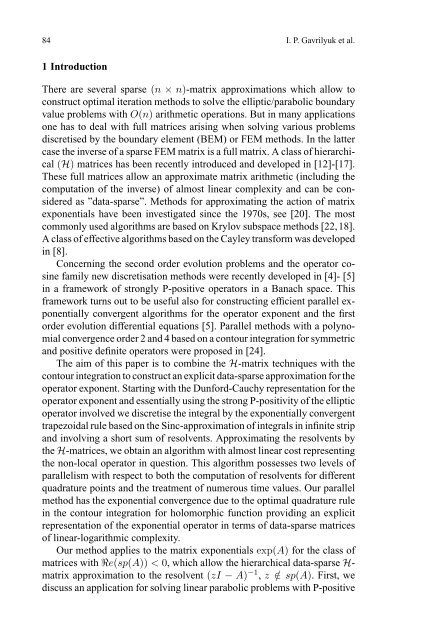H-Matrix approximation for the operator exponential with applications
H-Matrix approximation for the operator exponential with applications
H-Matrix approximation for the operator exponential with applications
You also want an ePaper? Increase the reach of your titles
YUMPU automatically turns print PDFs into web optimized ePapers that Google loves.
84 I. P. Gavrilyuk et al.<br />
1 Introduction<br />
There are several sparse (n × n)-matrix <strong>approximation</strong>s which allow to<br />
construct optimal iteration methods to solve <strong>the</strong> elliptic/parabolic boundary<br />
value problems <strong>with</strong> O(n) arithmetic operations. But in many <strong>applications</strong><br />
one has to deal <strong>with</strong> full matrices arising when solving various problems<br />
discretised by <strong>the</strong> boundary element (BEM) or FEM methods. In <strong>the</strong> latter<br />
case <strong>the</strong> inverse of a sparse FEM matrix is a full matrix. A class of hierarchical<br />
(H) matrices has been recently introduced and developed in [12]-[17].<br />
These full matrices allow an approximate matrix arithmetic (including <strong>the</strong><br />
computation of <strong>the</strong> inverse) of almost linear complexity and can be considered<br />
as ”data-sparse”. Methods <strong>for</strong> approximating <strong>the</strong> action of matrix<br />
<strong>exponential</strong>s have been investigated since <strong>the</strong> 1970s, see [20]. The most<br />
commonly used algorithms are based on Krylov subspace methods [22,18].<br />
A class of effective algorithms based on <strong>the</strong> Cayley trans<strong>for</strong>m was developed<br />
in [8].<br />
Concerning <strong>the</strong> second order evolution problems and <strong>the</strong> <strong>operator</strong> cosine<br />
family new discretisation methods were recently developed in [4]- [5]<br />
in a framework of strongly P-positive <strong>operator</strong>s in a Banachspace. This<br />
framework turns out to be useful also <strong>for</strong> constructing efficient parallel <strong>exponential</strong>ly<br />
convergent algorithms <strong>for</strong> <strong>the</strong> <strong>operator</strong> exponent and <strong>the</strong> first<br />
order evolution differential equations [5]. Parallel methods <strong>with</strong> a polynomial<br />
convergence order 2 and 4 based on a contour integration <strong>for</strong> symmetric<br />
and positive definite <strong>operator</strong>s were proposed in [24].<br />
The aim of this paper is to combine <strong>the</strong> H-matrix techniques <strong>with</strong> <strong>the</strong><br />
contour integration to construct an explicit data-sparse <strong>approximation</strong> <strong>for</strong> <strong>the</strong><br />
<strong>operator</strong> exponent. Starting <strong>with</strong> <strong>the</strong> Dun<strong>for</strong>d-Cauchy representation <strong>for</strong> <strong>the</strong><br />
<strong>operator</strong> exponent and essentially using <strong>the</strong> strong P-positivity of <strong>the</strong> elliptic<br />
<strong>operator</strong> involved we discretise <strong>the</strong> integral by <strong>the</strong> <strong>exponential</strong>ly convergent<br />
trapezoidal rule based on <strong>the</strong> Sinc-<strong>approximation</strong> of integrals in infinite strip<br />
and involving a short sum of resolvents. Approximating <strong>the</strong> resolvents by<br />
<strong>the</strong> H-matrices, we obtain an algorithm <strong>with</strong> almost linear cost representing<br />
<strong>the</strong> non-local <strong>operator</strong> in question. This algorithm possesses two levels of<br />
parallelism <strong>with</strong>respect to both<strong>the</strong> computation of resolvents <strong>for</strong> different<br />
quadrature points and <strong>the</strong> treatment of numerous time values. Our parallel<br />
method has <strong>the</strong> <strong>exponential</strong> convergence due to <strong>the</strong> optimal quadrature rule<br />
in <strong>the</strong> contour integration <strong>for</strong> holomorphic function providing an explicit<br />
representation of <strong>the</strong> <strong>exponential</strong> <strong>operator</strong> in terms of data-sparse matrices<br />
of linear-logarithmic complexity.<br />
Our method applies to <strong>the</strong> matrix <strong>exponential</strong>s exp(A) <strong>for</strong> <strong>the</strong> class of<br />
matrices <strong>with</strong> Re(sp(A)) < 0, which allow <strong>the</strong> hierarchical data-sparse H-<br />
matrix <strong>approximation</strong> to <strong>the</strong> resolvent (zI − A) −1 , z /∈ sp(A). First, we<br />
discuss an application <strong>for</strong> solving linear parabolic problems <strong>with</strong>P-positive
















